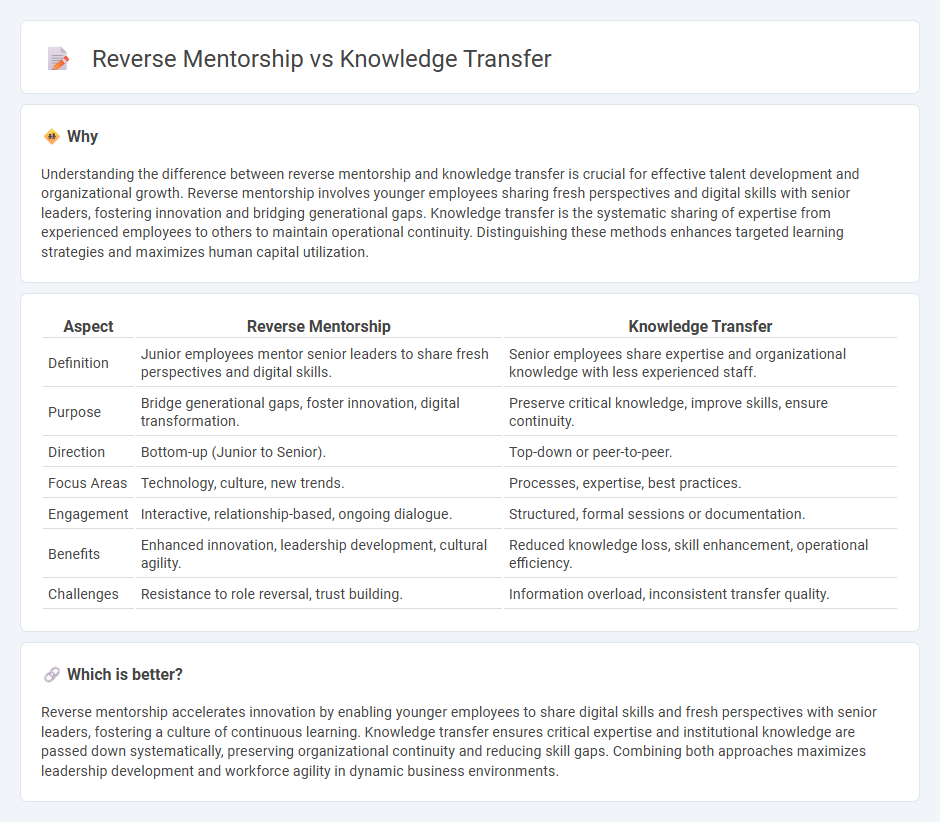
Reverse mentorship leverages younger employees' digital expertise to guide senior leaders, fostering innovation and agility within organizations. Knowledge transfer traditionally involves experienced employees imparting skills and insights to less experienced colleagues to preserve organizational knowledge. Explore how integrating reverse mentorship with knowledge transfer enhances leadership development and workforce capability.
Why it is important
Understanding the difference between reverse mentorship and knowledge transfer is crucial for effective talent development and organizational growth. Reverse mentorship involves younger employees sharing fresh perspectives and digital skills with senior leaders, fostering innovation and bridging generational gaps. Knowledge transfer is the systematic sharing of expertise from experienced employees to others to maintain operational continuity. Distinguishing these methods enhances targeted learning strategies and maximizes human capital utilization.
Comparison Table
| Aspect | Reverse Mentorship | Knowledge Transfer |
|---|---|---|
| Definition | Junior employees mentor senior leaders to share fresh perspectives and digital skills. | Senior employees share expertise and organizational knowledge with less experienced staff. |
| Purpose | Bridge generational gaps, foster innovation, digital transformation. | Preserve critical knowledge, improve skills, ensure continuity. |
| Direction | Bottom-up (Junior to Senior). | Top-down or peer-to-peer. |
| Focus Areas | Technology, culture, new trends. | Processes, expertise, best practices. |
| Engagement | Interactive, relationship-based, ongoing dialogue. | Structured, formal sessions or documentation. |
| Benefits | Enhanced innovation, leadership development, cultural agility. | Reduced knowledge loss, skill enhancement, operational efficiency. |
| Challenges | Resistance to role reversal, trust building. | Information overload, inconsistent transfer quality. |
Which is better?
Reverse mentorship accelerates innovation by enabling younger employees to share digital skills and fresh perspectives with senior leaders, fostering a culture of continuous learning. Knowledge transfer ensures critical expertise and institutional knowledge are passed down systematically, preserving organizational continuity and reducing skill gaps. Combining both approaches maximizes leadership development and workforce agility in dynamic business environments.
Connection
Reverse mentorship facilitates knowledge transfer by enabling younger employees to share digital skills and contemporary insights with senior leaders, fostering a culture of continuous learning. This bidirectional exchange accelerates innovation, enhances management strategies, and bridges generational gaps within organizations. Effective knowledge transfer through reverse mentorship improves decision-making and drives organizational agility in rapidly evolving markets.
Key Terms
Knowledge Transfer:
Knowledge transfer involves systematically sharing expertise, skills, and information within an organization to enhance employee performance and innovation. It enables seamless continuity of critical knowledge from experienced professionals to newer staff, reducing risks associated with knowledge loss. Explore effective knowledge transfer strategies and their impact on organizational growth to learn more.
Tacit Knowledge
Tacit knowledge, deeply embedded in personal experience and context, is effectively shared through knowledge transfer by senior experts guiding less experienced employees. Reverse mentorship leverages tacit knowledge from younger or less tenure employees, offering fresh insights and innovative approaches to senior leaders. Explore more to understand how these methods enhance organizational learning and innovation.
Best Practices
Best practices in knowledge transfer emphasize structured documentation, hands-on training, and leveraging digital tools to facilitate seamless expertise sharing across organizational hierarchies. Reverse mentorship thrives on open communication, mutual respect, and creating safe spaces for younger employees to impart technological insights and fresh perspectives to senior leaders. Explore more to enhance your organization's learning culture and innovation strategy.
Source and External Links
Knowledge Transfer for Universities and Research Institutions - WIPO - Offers insights into knowledge transfer processes from universities and research institutions to industry and government, highlighting formal and informal channels.
Knowledge Transfer: What it is & How to Use it Effectively - Helpjuice - Explains the concept of knowledge transfer and provides strategies for effective implementation within organizations using technology, culture, and infrastructure.
An Easy Guide to Creating an Effective Knowledge Transfer Process - Describes the importance of knowledge transfer in business settings and outlines how to create an effective process for sharing expertise and information.
 dowidth.com
dowidth.com